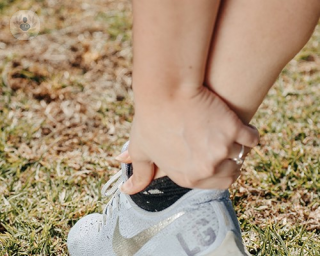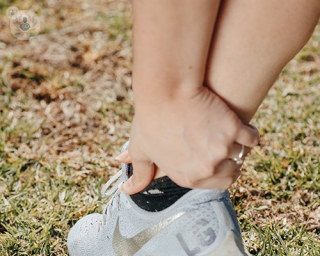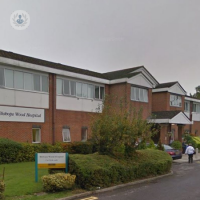What is the ankle?
The ankle is the joint that connects the foot to the leg and is important for being able to walk, run, or jump. It can be affected by a variety of injuries and conditions that can affect movement. The ankle is made up of three bones:
- Tibia (shin bone)
- Talus (sits above the heel bone)
- Fibula (runs next to the tibia)
In addition, the bony protrusions on your ankle are named as follows:
- Lateral malleolus – on the outside of the ankle at the base of the fibula.
- Posterior malleolus – at the back of the ankle at the base of the tibia.
- Medial malleolus – on the inside of the ankle, forming part of the tibia’s base.

Ankle function
The ankle can be described as a hinge-type joint with movement being allowed in one direction – both up and down. Other direction movements are allowed by other joints in the foot.
Pathologies of the ankle
- Sprained ankle – usually caused by an accidental twisting or turning motion to the ankle, damage to one of the ankle ligaments results.
- Breaks and fractures – result when any three of the ankle bones is fractured or broken. Tibia and fibula breaks and fractures are most common.
- Achilles tendinopathy (tendinitis and tendinosis) – inflammation and/or thickening of the Achilles tendon can cause pain, restricted movement and stiffness.
- Arthritis of the ankle – caused by gradual wear and tear
- Tarsal tunnel syndrome – caused by compression of the posterior tibial nerve, resulting in pain, the feeling of burning and pins and needles.
Treatments for ankle problems:
Many ankle injuries can benefit from the RICE method; Rest, Ice, Compression and Elevation, as well as pain medication. Other ankle injuries, such as breaks or fractures will require immobilisation in either an ankle cast or boot. More serious ankle problems may require surgery.
Which specialist treats ankle problems?
Orthopaedic surgeons may specialise in treating conditions of the foot and ankle.
11-13-2012 08-10-2023Ankle
Mr Jasdeep Giddie - Orthopaedic surgery
Created on: 11-13-2012
Updated on: 08-10-2023
Edited by: Sophie Kennedy
What is the ankle?
The ankle is the joint that connects the foot to the leg and is important for being able to walk, run, or jump. It can be affected by a variety of injuries and conditions that can affect movement. The ankle is made up of three bones:
- Tibia (shin bone)
- Talus (sits above the heel bone)
- Fibula (runs next to the tibia)
In addition, the bony protrusions on your ankle are named as follows:
- Lateral malleolus – on the outside of the ankle at the base of the fibula.
- Posterior malleolus – at the back of the ankle at the base of the tibia.
- Medial malleolus – on the inside of the ankle, forming part of the tibia’s base.

Ankle function
The ankle can be described as a hinge-type joint with movement being allowed in one direction – both up and down. Other direction movements are allowed by other joints in the foot.
Pathologies of the ankle
- Sprained ankle – usually caused by an accidental twisting or turning motion to the ankle, damage to one of the ankle ligaments results.
- Breaks and fractures – result when any three of the ankle bones is fractured or broken. Tibia and fibula breaks and fractures are most common.
- Achilles tendinopathy (tendinitis and tendinosis) – inflammation and/or thickening of the Achilles tendon can cause pain, restricted movement and stiffness.
- Arthritis of the ankle – caused by gradual wear and tear
- Tarsal tunnel syndrome – caused by compression of the posterior tibial nerve, resulting in pain, the feeling of burning and pins and needles.
Treatments for ankle problems:
Many ankle injuries can benefit from the RICE method; Rest, Ice, Compression and Elevation, as well as pain medication. Other ankle injuries, such as breaks or fractures will require immobilisation in either an ankle cast or boot. More serious ankle problems may require surgery.
Which specialist treats ankle problems?
Orthopaedic surgeons may specialise in treating conditions of the foot and ankle.


How ankle arthritis is diagnosed and treated (and if your ankle will need replacing)
By Mr Henry Willmott
2025-01-13
If your ankle feels stiff, swollen and painful, you might be wondering if you have arthritis. Learn from Mr Henry Willmott, renowned consultant orthopaedic surgeon, about how ankle arthritis is diagnosed and treated, and if surgery might be beneficial for getting you moving without pain again. See more


Understanding ankle sprains
By Mr Paul Halliwell
2025-01-13
In his latest online article, Mr Paul Halliwell gives us insights into complications of ankle sprains. He talks about why your ankle sprain may not be healing, the underlying issues and the signs that your ankle sprain may be more serious. See more


Ankle ligament tears: all you need to know
By Mr Shelain Patel
2025-01-13
Ankle ligament tears are injuries where the ligaments, which connect and stabilise bones in the ankle, are partially or completely torn, often due to excessive twisting or rolling of the ankle. Leading consultant orthopaedic foot and ankle surgeon Mr Shelain Patel explains how they occur, common symptoms and treatment options. See more


Why is my ankle injury not healing?
By Mr Stefan Weitzel
2025-01-13
Ankle injuries are very common and while most are mild sprains and typically take 2-4 weeks to heal, some may take even longer. However, you should always be noticing a gradual improvement in your symptoms as time goes by, and if you aren't, it can indicate something more serious. Mr Stefan Weitzel, one of our top consultant orthopaedic surgeons, explains what you should do if your ankle injury doesn't show signs of healing. See more
Experts in Ankle
-
Mr Billy Jowett
Orthopaedic surgeryExpert in:
- Bunion (hallux valgus)
- Arthritis
- Ankle
- Flat feet
- Achilles tendon
- Ankle arthroscopy
-
Mr Jordi Sanchez-Ballester
Orthopaedic surgeryExpert in:
- Ankle
- Foot
- Knee arthroscopy
- Arthroplasty
- Knee surgery
- Osteoarthritis
-
Mr Barry Rose
Orthopaedic surgeryExpert in:
- Ankle
- Bunion (hallux valgus)
- Foot
- Sports injuries
- Achilles tendon
- Plantar fasciitis
-
Mr Togay Koç
Orthopaedic surgeryExpert in:
- Bunion (hallux valgus)
- Ankle
- Heel spur
- Foot and ankle
- Toe pain
- Flat feet
-
Mr Haroon Majeed
Orthopaedic surgeryExpert in:
- Ankle tendonitis
- Ankle
- Achilles tendon
- Foot fracture
- Inflammatory arthritis
- Plantar fasciitis
- See all

Sheffield Orthopaedics Ltd
Sheffield Orthopaedics Ltd
Claremont Hospital, 401 Sandygate Rd, Sheffield
No existe teléfono en el centro.
By using the telephone number provided by TOP DOCTORS, you automatically agree to let us use your phone number for statistical and commercial purposes. For further information, read our Privacy Policy
Top Doctors

Bishops Wood Hospital - part of Circle Health Group
Bishops Wood Hospital - part of Circle Health Group
Mount Vernon Hospital, Rickmansworth Rd, Northwood HA6 2JW
No existe teléfono en el centro.
By using the telephone number provided by TOP DOCTORS, you automatically agree to let us use your phone number for statistical and commercial purposes. For further information, read our Privacy Policy
Top Doctors

Cleveland Clinic Portland Place Outpatient Centre
Cleveland Clinic Portland Place Outpatient Centre
24 Portland Place, W1B 1LU
No existe teléfono en el centro.
By using the telephone number provided by TOP DOCTORS, you automatically agree to let us use your phone number for statistical and commercial purposes. For further information, read our Privacy Policy
Top Doctors
-
Sheffield Orthopaedics Ltd
Claremont Hospital, 401 Sandygate Rd, Sheffield, SheffieldExpert in:
- Hip
- Orthopaedic surgery
- Orthopaedic spinal surgery
- Shoulder and elbow
- Joint replacement
-
Bishops Wood Hospital - part of Circle Health Group
Mount Vernon Hospital, Rickmansworth Rd, Northwood HA6 2JW, West LondonExpert in:
- Vascular Surgery
- Cancer
- Cardiology
- General Surgery
- Neurological spinal surgery
- Orthopaedic surgery
-
Cleveland Clinic Portland Place Outpatient Centre
24 Portland Place, W1B 1LU, Central LondonExpert in:
- Diagnosis of Cancer
- Diagnostics
- Women’s health
- Sports Medicine
- General practice
- Health check up
- Most viewed diseases, medical tests, and treatments
- Ulnar nerve entrapment
- Peripheral nerve block
- Peripheral neuropathy
- Joint pain
- Lumbar herniated disc
- Spinal surgery
- Minimal access surgery (keyhole surgery)
- Shoulder pain
- Osteoporosis
- Botulinum toxin (Botox™)








